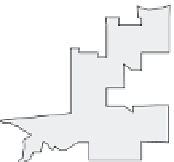Geography Reference
In-Depth Information
W
WEST VANCOUVER
VAN
V
N
NORTH VANCOUVER
V
N
V
NORTH
VANCOUVER
CITY
COQ
UITLAM
PORT
MO
ODY
Y
PORT
COQUITLAM
M
MAPLE
RIDGE
BURNABY
NA
PITT
MEADOWS
VANCOUVER
AN
Airport
RICHMOND
N
SURREY
Percentage
below LICO
LANGLEY
DELTA
0 - 39.8
39.9 - 48.2
48.3 - 53.9
54.0 - 62.5
0
0
2
miles
2 kilometers
62.6 - 100.0
WHITE
ROCK
HIT
K
No data
CBD
Figure 4.2
Households below the poverty line in 1996 among 1986-96 landings of self-designated
ethnic Chinese households, Vancouver CMA
poverty line.
23
In Vancouver's expensive westside neighbourhoods, the
British Properties and the Westwood Plateau, all tracts disclosed poverty
rates in excess of 40 percent, often over 50 percent, for ethnic Chinese
households landing between 1986 and 1996. There is a stunning incongru-
ity between high levels of consumption and the most meagre income flows.
But this is the same story, now multiplied across the map of the city, that
business migrants told me as we sat in their expensive homes concerning
low incomes, business failure and limited economic participation.
Ethnographic details are confirmed by census generalities, and offer an
interpretation of what is otherwise a profound census anomaly.
Census materials do not provide information on the landing class of
immigrants, and a sharper interpretation emerges from the Government
of Canada's Immigration Data Base (IMDB), a unique compilation of immi-
grant characteristics derived from landing cards, including class of entry,
that are linked with subsequent income tax returns. Individual data of
course are confidential and tabulations are made available to researchers in
highly aggregated form. Nonetheless they provide a valuable analytic
grid inaccessible from other sources. In an important study, Wang and
Lo (2005) examined IMDB files that reported income tax returns com-
pleted in 2000 (for the 1999 tax year) submitted by members of the almost
800,000 immigrants between 1980 and 2000 who listed a Chinese mother














































































































































































































































































































































